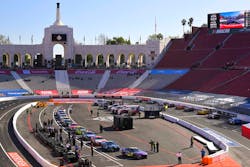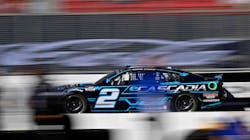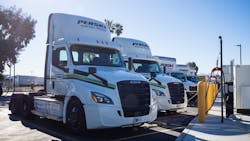Penske, Freightliner make CV history before NASCAR’s historic ‘Clash’
History was made this weekend when NASCAR held an exhibition on a short, quarter-mile track inside the Los Angeles Memorial Coliseum. The Busch Light Clash at the Coliseum was a historic event for North America’s premier auto racing league inside one of America’s iconic stadiums. But before the race-car drivers even started their engines on Sunday, commercial vehicle history was made outside the venue.
Team Penske and longtime partner Freightliner used a preproduction, fully-electric Freightliner eCascadia tractor to haul a full-size Team Penske race-car trailer to the event. The electric truck pulled the trailer from a Penske Truck Leasing location in Ontario, California, to the inaugural Clash in Los Angeles as part of Freightliner’s primary sponsorship of the No. 2 car, a Ford Mustang driven by NASCAR rookie Austin Cindric, who was decked out in eCascadia colors.
See also: California dreamin’ of transportation electrification
Like the upcoming Daytona 500, which opens up the 2022 NASCAR season later this month, the race to convert a trucking fleet from diesel to zero-emission can be long and grueling. But executives from Freightliner's parent company Daimler Trucks North America (DTNA) and Penske told FleetOwner that early preparation and planning can go a long way toward giving fleets the edge in adopting the new technologies of this decade.
If anyone knows about winning races, it’s Team Penske. Cars owned and prepared by the team have more than 590 major race wins, 650 pole positions, and 41 championships in open-wheel, stock car, and other racing competitions. While Penske’s eCascadia No. 2 car didn’t win, its No. 22 Shell-Pennzoil car, driven by Joey Logano, won the main event at the Coliseum on Sunday.
Both Penske and Freightliner said this was the first time a NASCAR stock car was brought to a race by a zero-emission vehicle. That vehicle is part of the Penske fleet of EVs testing alternate-powered trucks in various real-world environments in advance of Freightliner's full production of the electric trucks. “It’s been really exciting to see the driver excitement, the customer excitement, Penske’s excitement, and the acceptance of this truck,” Mary Aufdemberg, DTNA’s GM of product strategy and market development, told FleetOwner after Sunday’s race.
The eCascadia was on display throughout race weekend outside the Coliseum to give fans a firsthand look at the battery-electric truck. Decked out in navy with light blue piping, the No. 2 car’s paint job matches Freightliner’s prototype eCascadia that appears to be ripped right from the 1980s science fiction classic “Tron.”
The battery-electric truck’s delivery of the Penske No. 2 Ford Mustang race car got a lot of people excited outside the Coliseum. “I saw a number of very favorable social media comments that it was one of the best liveries on the track,” Randolph P. Ryerson, VP of marketing, communications, and events, at Penske Transportation Solutions, told FleetOwner. “Overall, it was a very, very positive reaction to the design of the truck and the car, which was really exciting for the Freightliner team.”
Building an electric truck fleet
The eCascadia used by Team Penske is part of the Freightliner Electric Innovation Fleet, which includes 20 battery-electric trucks in operation by Penske Truck Leasing and its customers. The fleet began operations in 2019 and was supported by the South Coast Air Quality Management District, which focuses on improving air quality in the South Coast Basin of Southern California and partially funded the project.
Freightliner is already taking orders for the electric Class 8 truck to go into full production later this year. In 2023, the OEM plans to begin producing its first battery-electric medium-duty truck, the Freightliner eM2. Earlier this year, DTNA announced a partnership with energy providers to create a nationwide charging network for medium- and heavy-duty trucks powered by battery-electric and hydrogen fuel cells.
A longtime Freighliner partner, Penske began working with the OEM on its EV future in 2018. Together, the companies have logged nearly half a million miles in Penske’s fleet of 10 eCascadia day cabs and 10 eM2 box trucks, running regular routes around Southern California. In that time, Penske has built out vehicle charging infrastructure at six locations around these routes.
“Penske is really an enabler of transportation,” Bill Combs, VP of sustainability at Penske, told FleetOwner. “We do have the Penske logistics arm that’s a large fleet—but we also have tens of thousands of customers that utilize our rental and lease vehicles every day. The goal was to get those 20 battery-electric vehicles in the hands of as many different types of customers running different types of operations as possible.”
All of those different operations have been a significant benefit in developing the emerging EV technology, according to DTNA’s Aufdemberg. “Transportation is not all the same,” she noted. “Depending on what you’re hauling, where you’re hauling, and what business you’re in—and our trucks are for business owners—we want everybody to have a really efficient, effective business in utilizing our trucks.”
The EV finish line is beyond California
There is still more work ahead within the trucking industry before EVs can replace most fleets’ diesel-powered heavy-duty trucks. But work in Southern California is paving the way for nationwide adoption. “For really wide acceptance, the technology is still evolving and infrastructure still needs to be built,” Aufdemberg explained. “Also, there’s a large understanding of what does it take to move a fleet from a diesel fleet into an electric fleet. There’s a massive transition that needs to happen in the industry.”
Freightliner wants to be part of that transition, she added. From working with fleet customers on what it takes to plan for and convert to EVs to the nationwide commercial charging network, DTNA is planning with NextEra Energy Resources and BlackRock Renewable Power. That U.S. network, which is expected to begin construction in 2023, will initially focus on critical freight corridors along the East Coast, West Coast, and Texas.
As its EV program intends to grow, Penske plans to increase its charging network beyond Southern California, Ryerson said. With more than 850 locations across the U.S., Penske is already “prepping sites to be ready to add charging stations” beyond SoCal, he said.
Aufdemberg said fleet interest in EVs is growing outside SoCal, too. “There are a lot of fleets where sustainability is really important to them,” she explained. “They’re looking for e-vehicles, zero-emissions vehicles outside of California as well. We feel a pull from our customers. This is definitely a ‘technology-pull’—not just a ‘technology-push’ for sure.”
Combs sees the EV push for heavy- and medium-duty operations growing beyond the Golden State. Penske is already working with California fleets that run vehicles beyond that part of the country. As battery range and weight capacities improve in EVs, adoption rates will also increase, he added. “We definitely see getting this into other parts of the country as a major move for battery-electric freight transportation. As Penske, we want to get these in other parts of the country. We want real-world experience running these in different climates, different types of range.”
For fleets considering electrification, the time to start planning is now—even if it’s not yet feasible to put EVs to work within a current operation. While there is a lot of development still needed before nationwide adoption, keeping up with the planning and developments can make a future fleet successful. “If you’ve started earlier, you’ll have more experience in how to perfect that adoption of the technology,” Combs said.
A NASCAR driver can’t win a race in just one lap. It’s about sustained success on hundreds of trips around the track. When it comes to EV conversion, Aufdemberg said, “it’s about getting early into the learning curve so that you can be the quickest to the finish line when it comes to an optimal route and optimal operation.”
About the Author
Josh Fisher
Editor-in-Chief
Editor-in-Chief Josh Fisher has been with FleetOwner since 2017. He covers everything from modern fleet management to operational efficiency, artificial intelligence, autonomous trucking, alternative fuels and powertrains, regulations, and emerging transportation technology. Based in Maryland, he writes the Lane Shift Ahead column about the changing North American transportation landscape.




